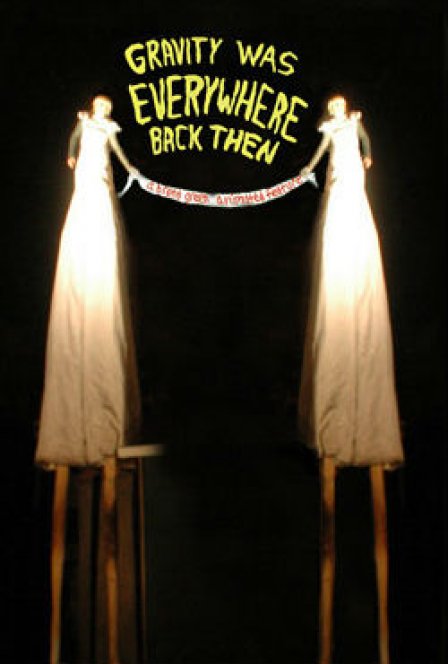Mary is dying. She doesn’t want Leonard to be alone. She buys him a bird and reminds him to put a sheet on it at night. We put a sheet over a bird cage to make our pet’s daily instincts sync up with our own. Because we keep the lights on after it gets dark while birds are inclined to shut their eyes with it. When two people love each other, and one is dying — they both adjust their daily routines to sync up while they still can. While sharing a roof, symbiosis is everything, and humans can’t just throw a blanket on one another when things don’t click anymore. I cling to this notion because it comes from one of the few “movie moments” Brent Green has allowed us to have all our own, without any kind of re-framing.
Gravity Was Everywhere Back Then is the film. The Gravity Was… that I am reviewing here is a video of a band playing live to said film with an accompanying book containing stills and text of everything said in Green’s live narration. The central preoccupation of the narrative is Leonard and Mary (based on real people). Leonard Wood is a dirt poor hardware store employee who is a sort of DIY cob-job sort. Mary is a similarly hobby-oriented person who collects and sells bird eggs. They meet and fall in love after an awkward courtship period. Mary gets cancer and Leonard despairs.
Now here’s where things get frustrating. Green brings up that Leonard decides to make a series of healing machines around and out of the house to help save Mary. This is the hook of the story — the bit in the trailer that makes one curious to see just what these machines are. Disappointingly, these never appear. All the odd details of the house were present and discussed before Mary gets sick. And the mechanical angels with recording machines are out of Mary’s dreams and not something Leonard built for her. Where are the healing machines? If they aren’t important, why mention them? This slipshod, reaching-as-grasping metaphorical approach to the nut and bolt relaying of Leonard and Mary’s story threatens to undercut the bracingness of Green’s performance about it.
Especially during his more emphatic narration, Green has an abrasive, Jad Fair-like command to his delivery that’s hard not to be affected by. Familiarity abounds from all facets. I’m reminded of Neil Gaiman, Ira Glass, mournful Louisville chamber rock… But the gaudy ephemera, bits of story and unabashed soul searching that make up the presentation easily eclipse this sort of baggage. The harried hand-written text of the narration presented in the book is nearly as evocative as the rough-hewn charm of the stop-motion imagery. The experience retains a stark immediacy that pounds its touchstones into clay, shaping less of a story but an impossible, litany for the diligent yet faithless. Green finds comfort in fetishism and decries fetishism in others as boring. He nitpicks, exalts and numbly hammers away with equilateral conviction. A breathless grace persists as one trips and stutters up and down the steps of his jagged, mercurial realm.
As striking as some of the imagery is, the strongest elements that emerge are of sound. The performance of the narration and music (with impressionistic sound effects and occasional foley by star, Donna K.) is so prevalent on this DVD, as to nearly render the film itself some sort rear projection for a live show. To be fair, though, Green calls this a “document,” suggesting that perhaps it was meant to be seen live wherein the audience could let their attention drift where it may. He didn’t use the word souvenir, however and this constant cutting back and forth between the rougher, Austin City Limits-style band footage and the more elegant visuals of the film nearly renders it as such.* Despite all the emotions one is made to go through, there is a slight residue of had-to-be-thereness. I found myself wondering what I was missing at times. Did Green actually fabricate the “healing machines” he speaks of, or was this something the budget didn’t provide for? Being that this is based on a true story I have to believe these machines existed. Did he not think to take photos when he visited Leonard’s house?
It’s not the most coherently told story, for better or worse. Green’s digressions, stirring as they are, never quite manage to eclipse the fact that there isn’t much of a film here. Just snatches of one and a lot of passionate fussing over the larger implications of life and loss in general. It’s like a maniacal think-piece of sorts. It would perhaps be better suited as an album with an illustrated book accompanying (a newspaper obituary clipping and a faded photograph of two people who look like they might have loved one another deeply). It would lose no potency and could manage to be significantly more like a document unto itself.
*Full Disclosure: With all apologies to Mr. Green, I slept on an opportunity to experience this screening/performance at Rensselaer Polytechnic Institute’s amazing EMPAC venue last Sept. As someone who constantly bitches about living in a cultural desert, I am especially annoyed with myself about this. The venue’s a mere 45-minute drive away and I have no decent excuse for missing it.

